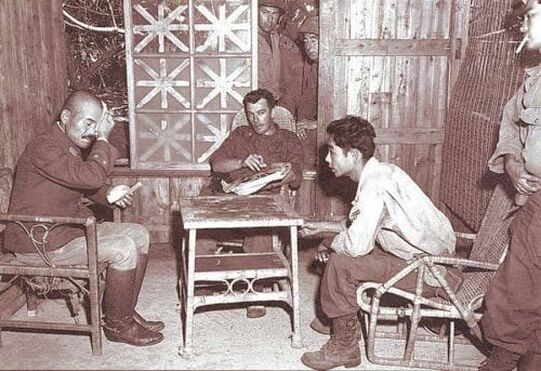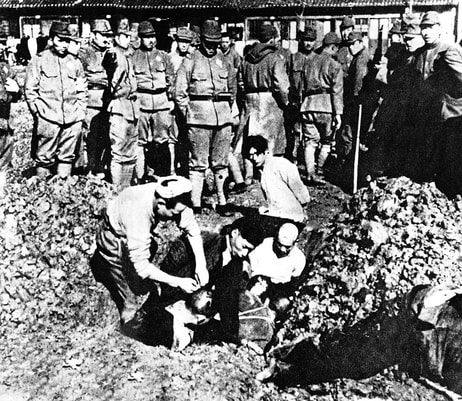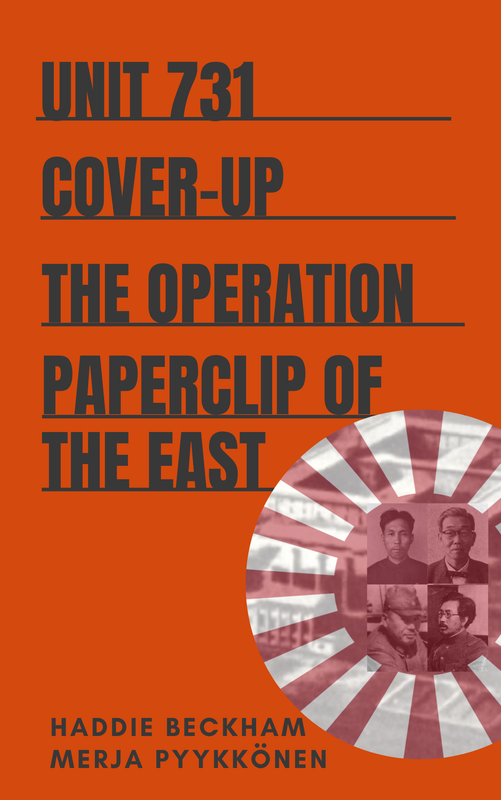- Home
- Stories
-
Internship
- Summer 2024 Internship
- Summer 2023 Internship
- Fall 2022 Internship
- Summer 2022 Internship
- Summer 2021 Internship
- Fall 2020- Spring 2021 Internship
- Summer 2020 Internship
- Fall 2019 Internship
- Summer 2019 Internship >
- School Year 2018-2019 Internship
- Summer 2018 Internship >
- Fall 2017 Internship
- Summer 2017 Internship >
- Books
- Archives
-
Resource Page
-
Supplementary Research Guides
>
- Unit 731 - Guide >
-
Philippines' Resistance - Guide
>
- Philippines World War II Timeline
- The Japanese Invasion & Conquest of the Philippines
- Bataan Death March
- Formation of Underground Philippines Resistance
- Supplies of the Guerrilla Fighters
- The Hukbalahap
- Hunter's ROTC
- Marking's Guerrillas
- United States Army Forces in the Philippines of Northern Luzon (USAFIP-NL)
- The Aetas
- Chinese and Filipino-Chinese Nationalist Guerrilla Units
- The Female Faces of the Philippine Guerrillas
- Rising Sun Flag - Guide >
- Pinay Guerrilleras - Guide >
- Fall of Singapore - Guide >
- Three Years and Eight Months - Guide >
- Siamese Sovereignty - Guide >
- The Khabarovsk War Crimes Trial - Guide >
- Unit 731 Cover-up : The Operation Paperclip of the East - Guide >
- Marutas of Unit 731 - Guide >
- Prince Konoe Memoir - Guide >
- Competing Empires in Burma - Guide >
- Battle of Shanghai - Guide >
- Ishi Shiro - Guide >
- Taiwan The Israel of the East - Guide >
- Seeking Justice for Biological Warfare Victims of Unit 731 - Guide >
- Rice and Revolution - Guide >
- Clash of Empires - Guide >
-
Hunger for Power and Self-SufficiencyI - Guide
>
- The Influence of War Rations on Post-War Culinary Transformations
- How World War II Complicated Food Scarcity and Invention
- American Military Innovations
- Government-Sponsored Food Inventions in Europe during World War II
- Feeding the Army: The Adaptation of Japanese Military Cuisine and Its Impact on the Philippines
- Mixed Dishes: Culinary Innovations Driven by Necessity and Food Scarcity
-
Denial A Quick Look of History of Comfort Women and Present Days’ Complication - Guide
>
- The Comfort Women System and the Fight for Recognition
- The Role of Activism and International Pressure
- The Controversy over Japanese History Textbooks
- The Sonyŏsang Statue and the Symbolism of Public Memorials
- Activism and Support from Japanese Citizens
- The Future of Comfort Women Memorials and Education
- Echoes of Empire: The Power of Japanese Propaganda - Guide >
- Lesson Plans >
-
Supplementary Research Guides
>
American intelligence and Unit 731
Although some of the international connections concerning the disapproval of the research and usage of BW were seemingly strong during World War II and after Japan’s surrender, the U.S. appears to have started its secrecy campaign on the topic at least as early as 1943. Some connections were stronger, such as that between the U.S. and the U.K., who frequently shared their pre-war reports on BW—even if this connection later weakened once
the U.S. occupied Japan. When the U.S. started its own, well organized BW studies at Camp Detrick in 1943, doubts and confusion arose about the worldwide communication of observed enemy activities involving BW usage. The topic was acknowledged as somewhat sensitive due to the potential panic it could cause among civilians and military troops, if any news should be leaked. In 1943, reports of Japanesenese atrocities towards American troops were discussed by President Roosevelt, MacArthur and the Joint Chief of Staff, who debated whether or not to release the information to the public. MacArthur himself first suggested sharing the information, but quickly reversed his opinion.
the U.S. occupied Japan. When the U.S. started its own, well organized BW studies at Camp Detrick in 1943, doubts and confusion arose about the worldwide communication of observed enemy activities involving BW usage. The topic was acknowledged as somewhat sensitive due to the potential panic it could cause among civilians and military troops, if any news should be leaked. In 1943, reports of Japanesenese atrocities towards American troops were discussed by President Roosevelt, MacArthur and the Joint Chief of Staff, who debated whether or not to release the information to the public. MacArthur himself first suggested sharing the information, but quickly reversed his opinion.
|
Regarding biological warfare, secrecy additionally encircled the U.S.’ own military attachés, secret services and military intelligence offices. No one was quite certain what kind of information should be distributed to the United States’ own departments, or even to their counterparts of other allied nations. This suspicion and the lack of proper reports could
have been the basis for the wall of secrecy upheld by the U.S., when it seized the information it received during and after the war. The secrecy was later justified with the safety of U.S.’s own troops in post-war Japan, and a positive outlook about Japan’s future was strongly promoted in order to move on from the horrors of the war. To possibly describe the attitude of how the Western nations approached the impeding interrogations of suspected BW scientists is colored by expectations the U.K. and U.S. had about Japanese people. When interrogating the former Pingfan scientist, Col. Enryo Hojo located in Germany, the head of the British BW research, Paul Fildes, said in 1945 that he was not surprised about the weak outcome of the interrogations, because “it would be very difficult to get information .... particularly from such people as the Japanese”. |
Interrogating a captured Japanese general
|
Despite being provided with statements from Japanese PWs, reports and letters from Chinese officials, and having their own confirmed sources of BW,
American intelligence maintained a seemingly careful and suspicious approach to the true scale of the Japanese BW research. Intelligence operations acknowledged some of the German and Japanese BW incidents as early as 1943, but mainly stood by their own “reliable sources”. It was no longer a secret that Japan was conducting a level of BW research, and utmost secrecy had to be maintained when discussing the topic and findings of intelligence departments.
American intelligence maintained a seemingly careful and suspicious approach to the true scale of the Japanese BW research. Intelligence operations acknowledged some of the German and Japanese BW incidents as early as 1943, but mainly stood by their own “reliable sources”. It was no longer a secret that Japan was conducting a level of BW research, and utmost secrecy had to be maintained when discussing the topic and findings of intelligence departments.
Dismissal of evidence
|
Moreover, a month prior to Thompson’s final conclusions, David Nelson Sutton from the Investigation Division of International Prosecution Section (IPS) had transmitted a 37 page report of his findings about the alleged Japanese use of CW and BW in China. He had accompanied Xiang Zhejun and Col. Thomas H. Morrow to China to investigate. This report was submitted to Keenan on April 12 after they returned to Tokyo. Sutton was specifically responsible for investigation of Japanese biological warfare, and Morrow was responsible for investigation of Japanese chemical warfare. Sutton’s report on biological warfare in China detailed events that occurred after the Japanese dropped grain and other substances in the air on October 4, 1940, in Quxian, Zhejiang province; October 27, 1940, in Nimbo, Zhejiang province; and November 4, 1941 in Changde, which was followed by the local plague outbreak, and presented evidence including the clinical records and analyses by epidemiologists.
|
Chinese civilians being buried alive by Japanese troops.
|
While Thompson’s investigation was coming to an end, the Tokyo War Crimes Trial was officially starting in May 1946. Soon after the trial had begun, the Chinese Division’s CW charges against the Japanese were erased from the IPS program. Moreover, the Soviets had gained valuable confessions from three captured Japanese BW personnel, who had provided details of the BW experiments. The Soviets offered to bring them to testify at the Tokyo War Crimes Trial, but the IPS was against it, with an excuse that they would not have enough credentials to be trusted in court nor were there any documents to support their claims. The chemical warfare proof was eliminated due to concern of CWS and G-2: Because of the U.S.’ own research on the topic, charges and indictments could cause more anxiety in the general population learning the opinion of the study and about CW usage.
Related Book
Unit 731 Cover-up :
|
|
Pacific Atrocities Education
730 Commercial Street San Francisco, CA 94108 415-988-9889 |
Copyright © 2021 Pacific Atrocities Education.
We are a registered 501 (c)(3) charity. |
- Home
- Stories
-
Internship
- Summer 2024 Internship
- Summer 2023 Internship
- Fall 2022 Internship
- Summer 2022 Internship
- Summer 2021 Internship
- Fall 2020- Spring 2021 Internship
- Summer 2020 Internship
- Fall 2019 Internship
- Summer 2019 Internship >
- School Year 2018-2019 Internship
- Summer 2018 Internship >
- Fall 2017 Internship
- Summer 2017 Internship >
- Books
- Archives
-
Resource Page
-
Supplementary Research Guides
>
- Unit 731 - Guide >
-
Philippines' Resistance - Guide
>
- Philippines World War II Timeline
- The Japanese Invasion & Conquest of the Philippines
- Bataan Death March
- Formation of Underground Philippines Resistance
- Supplies of the Guerrilla Fighters
- The Hukbalahap
- Hunter's ROTC
- Marking's Guerrillas
- United States Army Forces in the Philippines of Northern Luzon (USAFIP-NL)
- The Aetas
- Chinese and Filipino-Chinese Nationalist Guerrilla Units
- The Female Faces of the Philippine Guerrillas
- Rising Sun Flag - Guide >
- Pinay Guerrilleras - Guide >
- Fall of Singapore - Guide >
- Three Years and Eight Months - Guide >
- Siamese Sovereignty - Guide >
- The Khabarovsk War Crimes Trial - Guide >
- Unit 731 Cover-up : The Operation Paperclip of the East - Guide >
- Marutas of Unit 731 - Guide >
- Prince Konoe Memoir - Guide >
- Competing Empires in Burma - Guide >
- Battle of Shanghai - Guide >
- Ishi Shiro - Guide >
- Taiwan The Israel of the East - Guide >
- Seeking Justice for Biological Warfare Victims of Unit 731 - Guide >
- Rice and Revolution - Guide >
- Clash of Empires - Guide >
-
Hunger for Power and Self-SufficiencyI - Guide
>
- The Influence of War Rations on Post-War Culinary Transformations
- How World War II Complicated Food Scarcity and Invention
- American Military Innovations
- Government-Sponsored Food Inventions in Europe during World War II
- Feeding the Army: The Adaptation of Japanese Military Cuisine and Its Impact on the Philippines
- Mixed Dishes: Culinary Innovations Driven by Necessity and Food Scarcity
-
Denial A Quick Look of History of Comfort Women and Present Days’ Complication - Guide
>
- The Comfort Women System and the Fight for Recognition
- The Role of Activism and International Pressure
- The Controversy over Japanese History Textbooks
- The Sonyŏsang Statue and the Symbolism of Public Memorials
- Activism and Support from Japanese Citizens
- The Future of Comfort Women Memorials and Education
- Echoes of Empire: The Power of Japanese Propaganda - Guide >
- Lesson Plans >
-
Supplementary Research Guides
>


